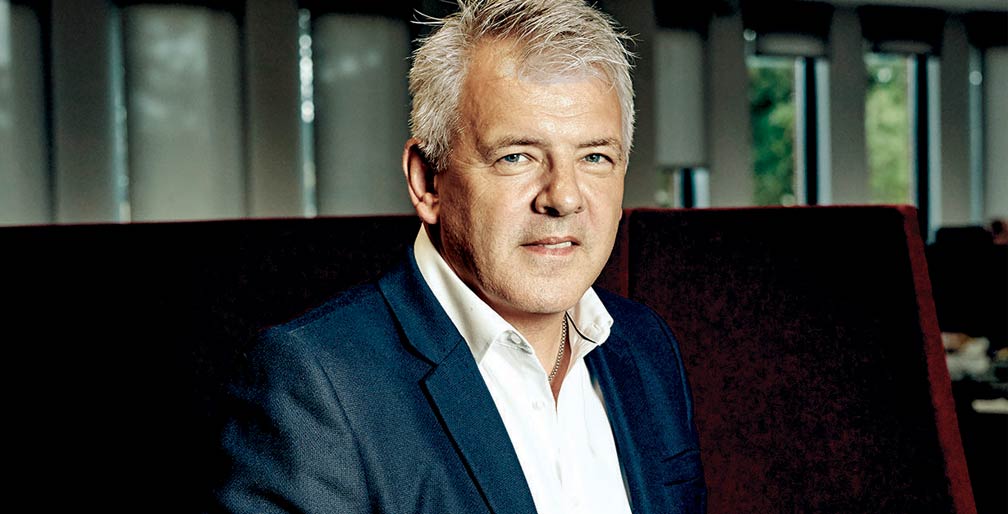The Refounding of TBWA\WorldHealth
TBWA\WorldHealth is a creature of disruption.
The health care advertising agency emerged in 2016 when global marketing and communications corporation Omnicom Global began consolidating some of its subsidiaries. At the time, Robin Shapiro and Sharon Callahan were each leading health care marketing agencies—Corbett and LLNS, respectively—within Omnicom. With the specter of organizational change on the near horizon, Ms. Shapiro and Ms. Callahan decided to take fate into their own hands. They felt they would be stronger together than apart—and stronger still by joining forces with a larger Omnicom marketing agency, TBWA.
TBWA gained its global reputation by spearheading a strategic process called Disruption®: looking at the conventional marketing approach, helping clients articulate their vision for a better future and then devising a disruptive idea that would bridge the two. Ms. Shapiro and Ms. Callahan both believed TBWA’s model would serve the health care industry well given its current state of upheaval. Increased public and governmental scrutiny, heightened price sensitivity, the need to do more with fewer resources, and a paradigm shift from mega brands to innovative medicines are all driving rapid change. “Being the disruption company is the right message, at the right time, for the right audience,” Ms. Shapiro says.
Omnicom agreed. So in April 2016, Ms. Shapiro and Ms. Callahan launched the new TBWA\WorldHealth.
But do not call it a merger.
“If you google ‘successful mergers,’ you come up with very slim pickings,” says Ms. Shapiro, who now serves as global president for TBWA\WorldHealth. “We were keenly aware of what hadn’t worked in other mergers: the sense of winners and losers, the feeling of one company taking over another.”
“In the best, most successful mergers, or even acquisitions, rather than integrating two enterprises together, the approach has been on developing the combined entity as a new company,” says Shideh Sedgh Bina, founding partner, Insigniam. “It goes beyond integration—which is important—to reconstitution.”
Instead, they called their union a “refounding.” It was about more than just semantics. “We changed the language in order to change the outcome,” Share on X Ms. Shapiro says. “Rather than deciding if we would be Corbett this or LLNS that, we created a new agency that would not look or function like any other agency.”
Setting the Right Tone
To kick things off and create a distinct and disruptive identity, Ms. Shapiro and Ms. Callahan selected seven leaders from their respective agencies’ ranks to shepherd the refounding process. “We knew they had to be part of the agency moving forward,” Ms. Shapiro says.
“We changed the language in order to change the outcome. Rather than deciding if we would be Corbett this or LLNS that, we created a new agency that would not look or function like any other agency.”
—Robin Shapiro
The team held full-day, off-site meetings every fortnight for several months to strategize. The manifesto they crafted would come to define the organization’s culture. With statements such as, “We’re the creative collective who are radically open, and who believe that the innovation uncovered and the productivity gained by disrupting conventional thinking can transform attitudes and behaviors in health care, and make the competition weep with envy,” the manifesto emphasizes the importance of disruption. Almost two years later, that same manifesto is still read aloud at the start of every TBWA\WorldHealth leadership meeting.
Following the organization’s launch, each member of the leadership team became accountable for a piece of the manifesto. For instance, to fulfill the manifesto’s description of the new agency as “radically open,” Ms. Shapiro’s team decided to share the organization’s financial information at monthly staff meetings. “That’s very unusual,” she says. “When you keep finances secret, it creates suspicion. Without information, people assume the worst. Ambiguity is always interpreted negatively. So we chose to be radically different from all other agencies.”
They also spent a couple of intense days creating a detailed organization chart. “That was really important to us because if people need anything, they need safety, and they need to understand who their new boss will be,” Ms. Shapiro says.
But the team did not erase every trace of Corbett and LLNS. Rather, it looked for pieces to preserve from each legacy agency via an exercise called “the attic,” which poses the question: If there’s a fire in your house and you have time to take only one thing from the attic, what would it be? The two agencies took the place of the house. From LLNS, the team kept a monthly award given to two or three employees who far exceed expectations. From Corbett, they kept the Corbett Foundation, a philanthropic nonprofit devoted to rare and underserved diseases.
Come Together
Calling the merger a refounding was one thing, but getting employees’ buy-in for the change was another. For the official launch, Ms. Shapiro and Ms. Callahan held an all-agency meeting. As employees entered the off-site location, the first thing they saw was a slide that read, “Welcome to your new agency. This agency doesn’t look or sound like any other agency. This is day one.”
Ms. Shapiro, Ms. Callahan and their leadership team, along with leaders from Omnicom, explained that the new agency would leverage the strengths of TBWA and its reputation—and that everyone present was among the new agency’s first employees. The positive tone had an immediate impact. “I was terrified that we would have all these people say, ‘I’m out of here.’ But people were very excited,” Ms. Shapiro says.
“Ms. Shapiro and Ms. Callahan were diligent and vigilant in addressing every aspect of building TBWA as if they were looking at that aspect newly for the first time,” says Ms. Sedgh Bina. “There was almost no reliance on ‘the way we have done things in the past.’ All the conversations were ‘how are we going to do this at our new agency?’”
After that first meeting, the leadership team held one-on-one sessions with key senior staff members to allay any fears and address any questions. In addition, Ms. Shapiro’s team created an On Your Mind portal where employees could post their questions, which were then answered in monthly all-staff meetings. “In those meetings, we addressed concerns and shared best practices and also made people laugh,” Ms. Shapiro says. The transition’s success depended on communication, she says—constant, open communication.
“The values don’t live on a wall or on a piece of paper that’s framed and put on someone’s desk. We embed the values in everything we do.” —Robin Shapiro
Despite the well-executed introduction, employees from the legacy companies were hesitant to actually come together. The leadership team had carefully thought through office seating so employees would mix and mingle, but the Corbett and LLNS groups still tended to only socialize with their original colleagues. To break this habit, Ms. Shapiro and the leadership team launched Culture Club—a group that spearheads cultural and volunteer events in which every employee can participate. It was a way for TBWA\WorldHealth to start creating its own ethos.
Beyond the bonding issues, Ms. Shapiro also encountered seemingly countless personnel-related decisions—from whether or not the new agency should keep summer Fridays to how to conduct performance management. To address these topics, the human resources team led a weekly change management meeting. The agency’s leaders discussed every change with employees—repeatedly. “Never underestimate the value of communication,” Ms. Shapiro says. “When you don’t communicate, everyone thinks the worst.”
For instance, when the agency decided to change merit-increase reviews from an annual to a quarterly process, employees were concerned and confused—until Ms. Shapiro and her colleagues explained that the agency wanted to spread out its merit-related costs over the year so they did not hit the agency all at once.
The Founding Values
While TBWA\WorldHealth’s manifesto came from the top, Ms. Shapiro and her team realized they also needed to establish the company’s values—and those needed to come from the bottom. “People align their personal values with the company they work for,” she says. Her team wanted to know what employees valued both professionally and personally. So surveys about values were sent out throughout the agency, and by the end of the year, a committee of employees assessed the results. The values statement that came out of them underlines TBWA\WorldHealth’s commitment to transparency, trust and innovation: “We are driven to get real, be honorable, do good, stay restless and raise hell.”
Just as they had with the manifesto, TBWA\WorldHealth’s leaders understood that the agency’s values were more than just words and had to be put into action. “The values don’t live on a wall or on a piece of paper that’s framed and put on someone’s desk,” Ms. Shapiro says. “We embed the values in everything we do.” For instance, the agency uses its five values to organize its monthly staff meetings, and hands out annual awards to the employees who best personify each value.
By creating a workplace aligned with employees’ values, the agency draws the right talent—people with the skills to create disruptive marketing campaigns. “If we’re a destination agency for the best talent, that talent will help our clients achieve their objectives. We’ll retain those clients, and we’ll then be able to continue to invest in great talent,” Ms. Shapiro says. “If you do it well, it’s a beautiful circle.”
TBWA\WorldHealth stands out from its competitors because it embodies the idea of Disruption®, she says: “Unfortunately, so many marketing plans are done because somebody else did them before.” By contrast, TBWA\WorldHealth begins each client relationship by bringing together the client’s and the agency’s stakeholders for one full day to begin drawing a Disruption® road map. That road map consists of three components. On the left is the convention box: “This is marketing status quo,” Ms. Shapiro says. On the right is the vision circle: This is what the client wants to achieve. Between them is a triangle holding the disruption: “That’s the idea that will get us from convention to a more purposeful and profitable future.” The road map then guides the agency’s entire relationship with each client, whether it is a large firm like Merck or a smaller one like Braeburn. “We begin every client relationship by looking at what we can do differently from everyone else.”




